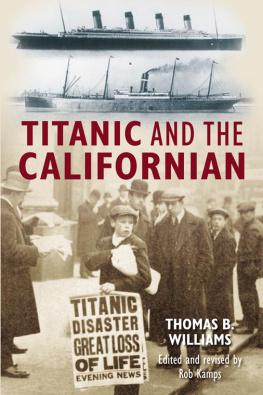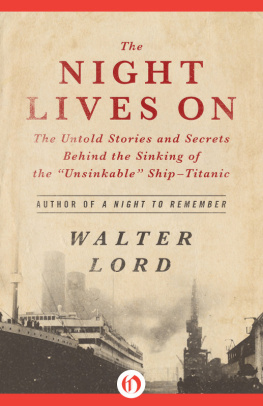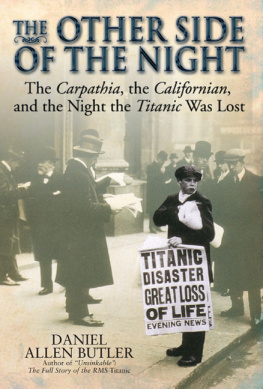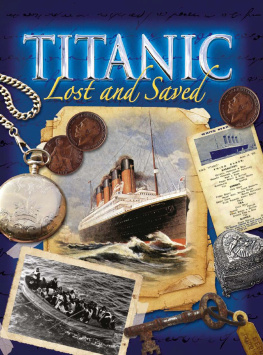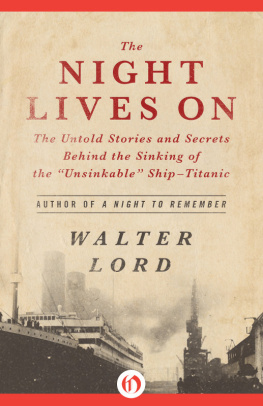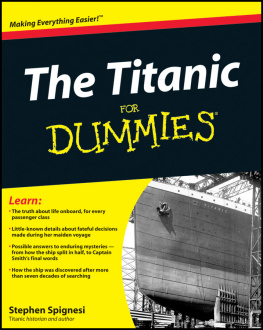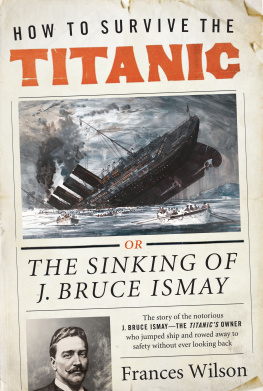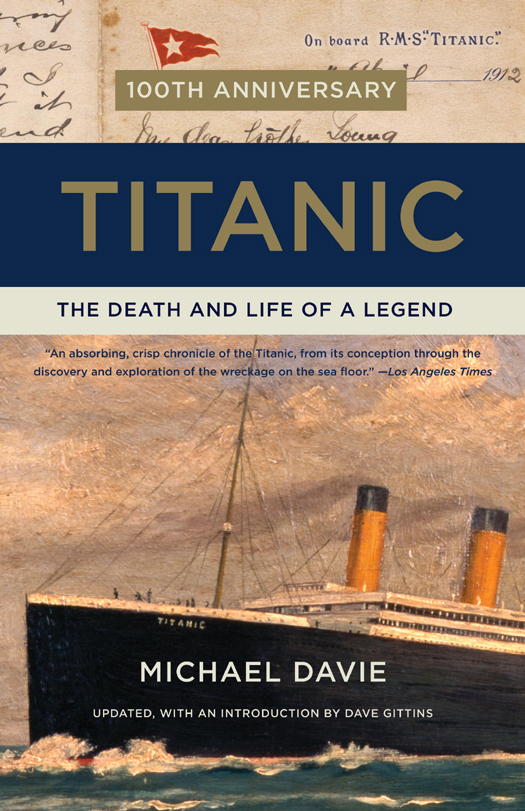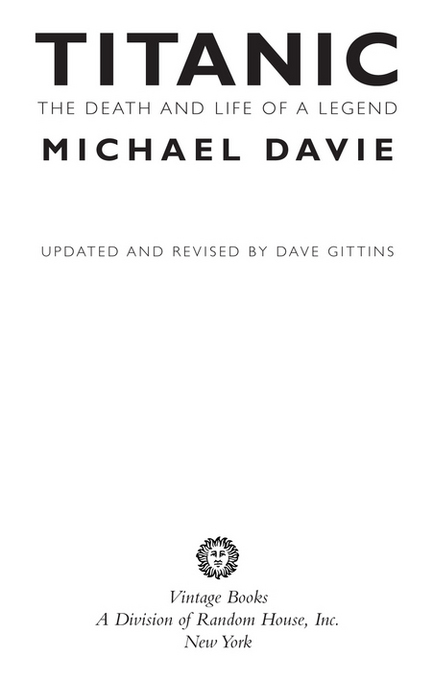MICHAEL DAVIE
TITANIC
Michael Davie was a leading British journalist. He was a reporter, columnist, and editor for the London Observer and the Melbourne (Australia) Age, and wrote books on topics as varied as Lyndon B. Johnson, California, and cricket. He died in 2005.
Dave Gittins lives in Adelaide, South Australia. He is the author of Titanic: Monument and Warning and coauthor of Report into the Loss of the SS Titanic: A Centennial Reappraisal.
ALSO BY MICHAEL DAVIE
LBJ: A Foreign Observers Viewpoint
California: The Vanishing Dream
The Diaries of Evelyn Waugh (Editor)
FIRST VINTAGE BOOKS EDITION, APRIL 2012
Copyright 1986 by Michael Davie
Introduction and appendix copyright 2012 by Dave Gittins
All rights reserved. Published in the United States by Vintage Books,
a division of Random House, Inc., New York. Originally published in England
as The Titanic by The Bodley Head, London, and subsequently published in
hardcover in the United States by Alfred A. Knopf, Inc., New York, in 1987.
Vintage and colophon are registered trademarks of Random House, Inc.
The poem Master and Man by Ben Hecht was originally published in
The Grand Rapids Herald, April 19, 1912.
The Library of Congress has cataloged the Knopf edition as follows:
Davie, Michael.
Titanic : the death and life of a legend.
p. cm.
1. Titanic (steamship). 2. ShipwrecksNorth Atlantic Ocean. I. Title.
G530.T6D38 1987
363.I23091631 86-46021
eISBN: 978-0-307-94840-3
www.vintagebooks.com
Cover design: Abby Weintraub
Cover images: Panting by T.H. John Mary Evans Picture Library; letter and life preserver Mary Evans Picture Library
v3.1
To Peter
CONTENTS
ILLUSTRATIONS
The Harland & Wolff yard in Belfast. The gantry used for the construction of the Titanic is in the background.
A White Star Line advertisement for Triple Screw RMS Olympic and Titanic, 45,000 tons each. The Largest Steamers in the World.
The Titanic leaving Belfast.
Lord Pirrie and J. Bruce Ismay inspecting the Titanic before her launching on May 31, 1911.
The boat deck of the Titanic.
The Titanics reading and writing room.
A corner of the Titanics gymnasium.
Captain E. J. Smith.
Second Officer Charles Herbert Lightoller.
A section through the Titanic from the Illustrated London News, April 1912.
The sinking: a contemporary artists impression from the Sphere, April 27, 1912.
The Titanics last message: C Q D and S O S were distress calls; MGY was the Titanics call sign.
Colonel and Mrs. J. J. Astor.
Survivors from the Titanic approaching the Carpathia.
J. Bruce Ismay, hand to moustache, giving evidence to the Senate inquiry in the Waldorf-Astoria Hotel, New York.
Senator William Alden Smith, chairman of the U.S. Senate inquiry.
Lady Duff Gordon.
Captain Lord.
Guglielmo Marconi (right) with Godfrey Isaacs.
Harold Bride being carried off the Carpathia in New York.
All these Southampton children lost a father, brother, uncle, or cousin on the Titanic.
J. Bruce Ismay giving evidence to the British inquiry.
Outside the White Star offices in Southampton; drawn for the Sphere by H. M. Paget.
Artists impression of Quartermaster Hitchins giving evidence to the British inquiry.
Lord Mersey (right) and his son, the Hon. Clive Bigham, arriving at the British inquiry.
Embalming a corpse aboard the Mackay-Bennett.
Undertakers and coffins on the jetty in Halifax, Nova Scotia, awaiting bodies picked up by the Mackay-Bennett.
Dr. Robert Ballard.
Members of the Franco-American team that found the Titanic. Standing in front of Argo (from left to right): Jean-Louis Michel; Lieutenant George Rey, U.S. Navy; Jean Jarry; Dr. Robert Ballard; and Bernard Pillaud.
The research vessel Knorr returning to Woods Hole in September 1985.
Two cranes, still locked into position on the deck of the Titanic on the seabed.
Bottles of wine, including French Bordeaux, scattered over the ocean floor around the wreck. A photograph taken by the Woods Hole expedition of 1985.
ACKNOWLEDGMENTS
My thanks are due especially to the following: Anne Chisholm, Archibald Chisholm, Sir Andrew Duff Gordon, John Grigg, Mrs. Dorothy Ismay, Edward S. Kamuda, Russ Lownds, Howard Matson, Viscount Mersey, Edith Newhall, Patrick Stenson, Jesse Stoecker, Robert Straus, John B. Thayer, and members of the Halifax Maritime Museum, the Halifax Public Archives, Harland & Wolff, the International Ice Patrol, the Library of Congress, the Marine Library of the Department of Transport, the New York Public Library, the Philadelphia Maritime Museum, the Public Record Office, the Southampton Public Library, the Ulster Folk and Transport Museum, the Widener Branch of the Free Library of Philadelphia, and the Woods Hole Oceanographic Institution. Most generously, Michael Moss of the University of Glasgow made available before publication his research for the official history of Harland & Wolff.
Copyright photographic material is reproduced by permission of the following: the Ulster Folk and Transport Museum; Harland & Wolff; Radio Times Hulton Picture Library; Beken of Cowes; the Cork Examiner; the Illustrated London News; the Southampton Echo; the Mercantile Marine Service Association; the Marconi Company; Halifax Public Archives; the Woods Hole Oceanographic Institution; Popperfoto; and Associated Press.
While every effort has been made to trace the correct owners of all copyright material reproduced in this book, the publishers regret any errors of attribution that may have unwittingly occurred and will be happy to make suitable acknowledgment in any future editions.
FOREWORD
During his career as a journalist and newspaper editor in the U.K. and Australia, Michael Davie (19242005) wrote on a wide range of topics, including international relations, religion, American politics, cricket, and much in between. Though he would self-deprecatingly call himself a scribbler, the prose style in his newspaper stories and his several books was of the highest quality, combining, as a former colleague described, a graceful style with a sharp edge. Many younger journalists, who worked with him at The Observer, or during his later time as editor of The Age in Melbourne, Australia, remembered him as a well-loved mentor.
Davie brought special qualifications to the story of the Titanic. The reporting skills and storytelling ability hed learned in the newsroom take the book beyond a dry recitation of discovered facts, and his considerable knowledge of English and American politicsdisplayed in his books on Lord Beaverbrook and President Lyndon Johnsoninform this history of a tragedy that linked these nations. He also had experience at sea. Davies Oxford education was interrupted when as a member of the Royal Navy Volunteer Reserve he served from 1942 to 1946. Our author thus combined talent at the typewriter with knowledge of the hard realities of the sea.


